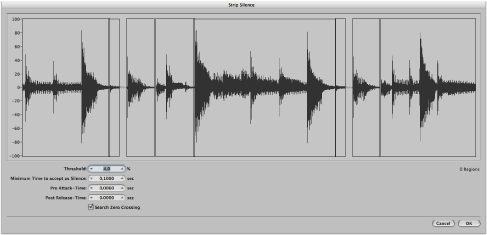Getting to Know the Strip Silence Window
The main parameters of the Strip Silence window are as follows:

- Threshold: Use to define the amplitude level that a passage must exceed, in order to be defined as a region. In terms of the number and length of regions created by the process, this is the most important parameter. As a general rule: a higher Threshold value leads to numerous short regions. Low values create fewer large regions.
- Minimum Time to accept as Silence: Use to define the length of time that a section must be below the Threshold value, before it is considered a gap. Very small values tend to increase the number of regions, because even short dips in amplitude are interpreted as silence. Higher values prevent sections of audio from being interrupted by fluctuating amplitudes.
- Pre Attack Time: Use to add a defined amount of pre-roll to the beginning of all regions created by the Strip Silence process. High threshold values prevent any amplitudes with slower attack times from being chopped. This function is useful for nonpercussive material such as vocals, wind instruments, strings, and so on. Overlaps are permitted—the pre-delayed start point of a region can extend back to the end of the previous region—but only if the Threshold value is not exceeded. The Pre Attack Time doesn’t affect the anchor position, which means the absolute position of the audio data (in the project) is retained.
- Post Release Time: Use to define an automatic release time for the end points of all regions, avoiding abrupt cutoffs to amplitudes that fade out gradually (particularly if you have set a high Threshold value); for example, cymbals, open hi-hats, snares with long reverb tails, vocals, and so on. This parameter does not allow overlaps. This means that region end points cannot extend beyond the start point of the following region. The Post Release Time doesn’t affect the anchor position, which means the absolute position of the audio data (in the project) is retained.
- Search Zero Crossings: Select this checkbox to automatically snap the region start and end points to the nearest waveform zero crossings.